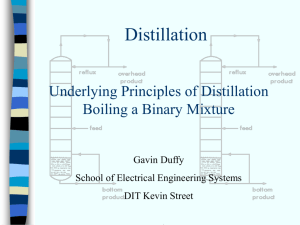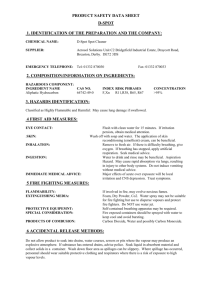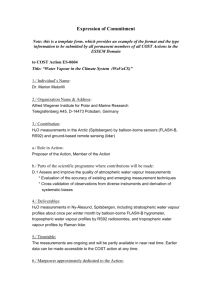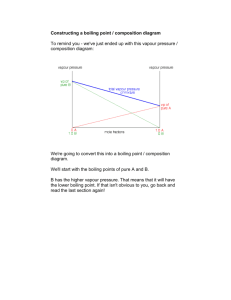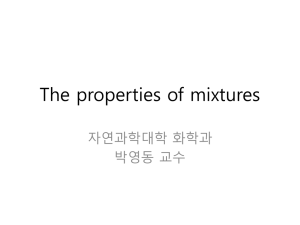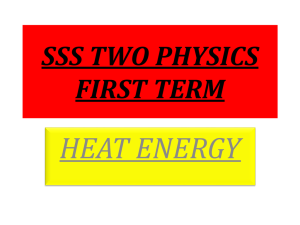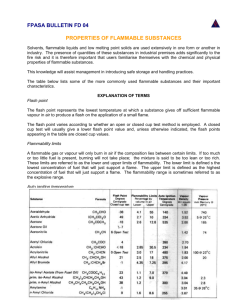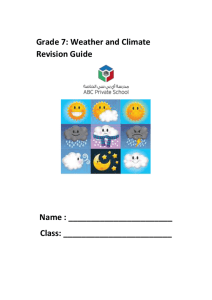Boiling a mixture - School of Electrical
advertisement
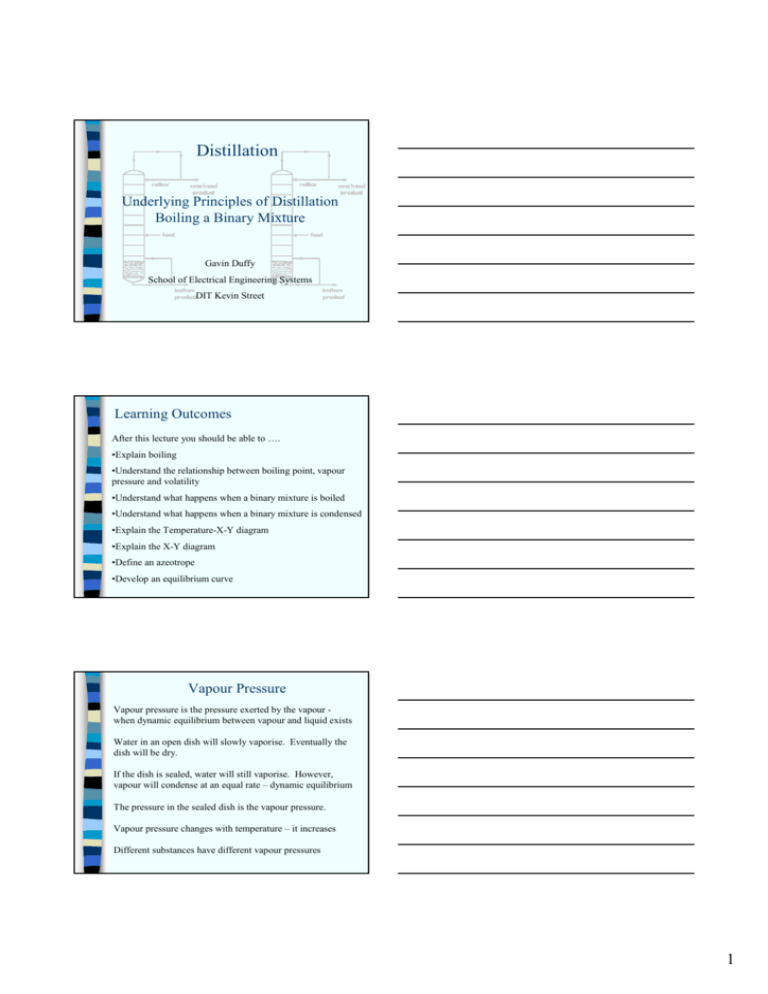
Distillation Underlying Principles of Distillation Boiling a Binary Mixture Gavin Duffy School of Electrical Engineering Systems DIT Kevin Street Learning Outcomes After this lecture you should be able to …. •Explain boiling •Understand the relationship between boiling point, vapour pressure and volatility •Understand what happens when a binary mixture is boiled •Understand what happens when a binary mixture is condensed •Explain the Temperature-X-Y diagram •Explain the X-Y diagram •Define an azeotrope •Develop an equilibrium curve Vapour Pressure Vapour pressure is the pressure exerted by the vapour when dynamic equilibrium between vapour and liquid exists Water in an open dish will slowly vaporise. Eventually the dish will be dry. If the dish is sealed, water will still vaporise. However, vapour will condense at an equal rate – dynamic equilibrium The pressure in the sealed dish is the vapour pressure. Vapour pressure changes with temperature – it increases Different substances have different vapour pressures 1 Boiling Boiling occurs when the vapour pressure equals the surrounding atmospheric pressure Water, at atmospheric pressure, will boil at 100 °C Water, at a temperature of 82 °C, will boil if the pressure is reduced to 0.5 of an atmosphere. Water, at a temperature of 25 °C, has a vapour pressure of 0.03 atmospheres What is the VP of water at 50 °C What is the boiling point of water at the top of Everest? (Source for data: Table 2-5 in Perry) Variation of atm pressure with height What is the atmospheric pressure at the top of Mount Everest? The following empirical formula can be used to calculate this pressure P = Po(1 + H.k/To)gM/-Rk – Po = atmoshperic pressure (101,325 Pa) – g = acceleration due to gravity (9.81 m/s2) – M = molecular weight of air (0.029 kg/mol) – R = universal gas constant (8.314 J/mol K) – H = height (m) – k = temp gradient over height = -0.0065 K/m – To = Temp at ground level (298 K) Aside - To calculate the temperature of air at this elevation so we use another empirical formula: T = To + H.k – To , H and k = same as above – Source – wikipedia. Volatility Liquids with high vapour pressures are said to be volatile. It is the degree to which it tends to transfer from the liquid to vapour state Water, at a temperature of 25 °C, has a vapour pressure of 0.03 atmospheres Methanol, at the same temperature, has a vapour pressure of 0.16 atmospheres Methanol is more volatile than water => more likely to be found as vapour. Vapour pressure is a measure of volatility. Methanol has a lower boiling point (65 °C) than water Volatile liquids have low boiling points Volatility = Pa/xa (Pa= partial pressure, xa = mole fraction) 2 Relative Volatility Relative volatility is the ratio of the volatilities of two components It indicates how easy or difficult a particular separation by distillation will be α ab = Pa xa Pa = partial pressure of MVC xa = mole fraction of a in the liquid MVC = more volatile component Pb xb Relative Volatility If α is equal to 1, separation is not possible If α is close to 1, separation is difficult. If α is large, separation is easy α is a function of temperature. It can change throughout the column. It is fairly steady for most systems (see C&R Vol 6 p434 for more). For example, for Benzene-Toluene, α rises as the temperature falls. Therefore, reduce the temperature to ease the separation. To reduce T, decrease the pressure in the column. Activity – define basic terms Think, pair, share the following concepts: •Define vapour pressure •What is volatility? •When does a liquid boil? •Explain why you can’t get a hot cup of tea at the top of Mount Everest! •Why do pressure cookers cook food faster? 3 Binary Mixtures Mix two components, e.g. Methanol and Water b.p. of Meth = 65 °C, b.p. of H2O = 100 °C b.p. of mixture = somewhere in between (not always so!) Boiling point of the mixture depends on the relative amounts of the two components present A mixture containing 30% Meth, 70% H2O has a b.p. of 78 °C. We call this the ‘bubble point’. The composition of this bubble is different to the composition of the liquid! That’s how distillation works! A T-x-y Diagram – Meth H2O Bubble Methanol Water VLE (T-x-y) Dew 105 100 95 Temp C 90 85 80 75 70 65 60 0.0 0.1 0.2 0.3 0.4 0.5 0.6 0.7 0.8 0.9 1.0 Xa, Ya (Meth) The T-x-y Diagram Rules The more volatile component (MVC) is labeled a x is the liquid phase concentration and y is the vapour xa = mole fraction of a in liquid, etc. Bubble point curve and Dew point curve are both shown Bubble = Dew for pure components only Subcooled liquid beneath bubble point curve Super heated vapour above dew point curve Both liquid and vapour phases exist in between Would the diagram look different if the pressure was changed? 4 Boiling a Mixture – Methanol Water Heat a 30%Meth 70%H2O mixture so vapour can’t escape but Pressure is constant Bubble Methanol Water VLE (T-x-y) Dew 105 1st bubble of vapour formed at 78°C 100 95 Bubble composition is 65%Meth 35%H2O Temp C 90 85 F L 80 V Liquid becomes less conc in Meth so BP increases 75 At 83°C liquid is 15% Meth, vapour is 55% 70 65 60 0.0 0.1 0.2 0.3 0.4 0.5 0.6 0.7 0.8 0.9 1.0 Xa, Ya (Meth) Boiling a Mixture contd The relative amounts of liquid, vapour and feed are given by Bubble Methanol Water VLE (T-x-y) Dew 105 Liquid FV 55 − 30 = = = 62.5% Feed LV 55 − 15 Vapour LF 30 − 15 = = = 37.5% Feed LV 55 − 15 100 95 Temp C 90 85 F L 80 V Liquid continues to boil 75 At 92 °C, conc of vapour is 30% Meth. 70 65 No liquid left 60 0.0 0.1 0.2 0.3 0.4 0.5 0.6 0.7 0.8 0.9 1.0 Super heated vapour Xa, Ya (Meth) Condensing a Binary Mixture Cool the super heated vapour, 30% Meth Bubble Methanol Water VLE (T-x-y) Dew First droplet forms at the dew point - 92 °C 105 Drop composition = 5% Meth, 95% H2O 100 95 Vapour becomes less conc in H2O so dewpoint decreases Temp C 90 85 F L 80 V Eventually, at 78 °C, all vapour has condensed. 75 70 65 60 0.0 0.1 0.2 0.3 0.4 0.5 0.6 0.7 0.8 0.9 1.0 Xa, Ya (Meth) 5 Distillation = Boiling AND Condensing Heat the mixture partial vaporisation Bubble Methanol Water VLE (T-x-y) Dew Vapour has higher Xa Remove the vapour by condensation to give liquid of higher Xa 105 100 95 Cool superheated vapour - partial condensation 85 80 Liquid has lower Xa 75 70 65 60 0.0 0.1 0.2 0.3 0.4 0.5 0.6 0.7 0.8 0.9 1.0 Distillation column encourages repeated partial vaporisation and condensation throughout the column Xa, Ya (Meth) The X-Y Diagram An alternative method of presenting Vapour Liquid Equilibrium (VLE) data Xa is plotted against Ya – usually a curve The X=Y line is also shown Data and plot are for a constant pressure only An easy way to estimate how many distillations are required to achieve a certain purity An X-Y diagram – Meth H2O Methanol Water VLE 1.0 0.9 0.8 0.7 Ya (Meth vapour) Temp C 90 0.6 0.5 0.4 0.3 0.2 0.1 0.0 0.0 0.1 0.2 0.3 0.4 0.5 0.6 0.7 0.8 0.9 1.0 Xa (Meth liquid) 6 Activity – X-Y for Eth H2O Ethanol and Water are separated by distillation. What does the X-Y curve for this binary mixture look like. 1. Find the T-x-y data. Try Perry (limited source for data ) 2. Plot the curve on graph paper Now, think about the following: Fermentation gives an ethanol conc. of about 15 to 20%. What happens when the mixture is boiled? 7
